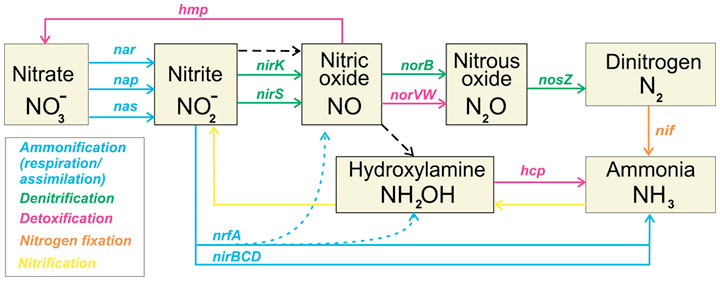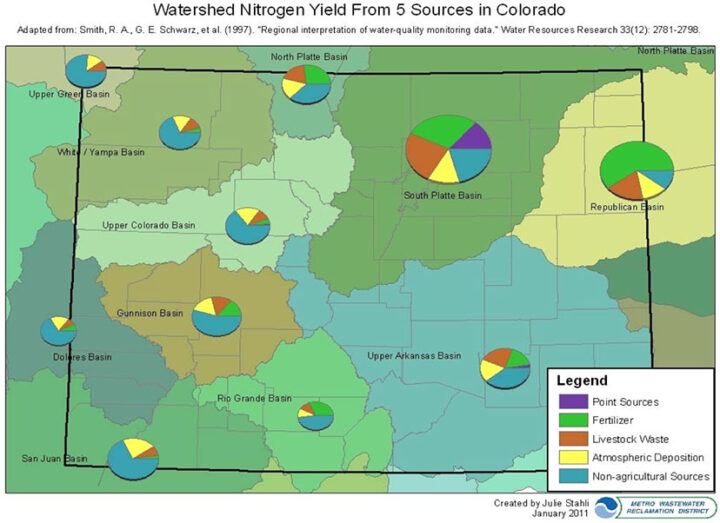Nationally, nutrients are one of the top causes of water quality impairments according to EPA. Reducing the point sources will cost billions of dollars nationwide and may not improve the streams due to nutrients entering streams from of non-point sources…
— from “Nutrient Overview” written for the City of Pueblo, Colorado, 2014.
We’ll be talking today about ‘point’ and ‘non-point’ sources.
As we’ve been discussing in this editorial series, water treatment and wastewater treatment are getting more expensive in Colorado, in spite of — or maybe because of — technological advancements.
Put some bureaucrats into a mixing bowl with some new technologies, and it just might wind up costing the taxpayers a pretty penny.
Nationally, ‘nutrient pollution’ is one of the key water quality problems facing the Environmental Protect Agency (EPA) — and also here in Colorado, facing the Colorado Department of Public Health and Environment (CDPHE), an agency that takes its marching orders from the EPA.
We might think ‘nutrients’ are a good thing, considering the Latin root of the word, meaning, “to suckle or nourish”.
But as a wise man named Aesop once wrote:
«Είναι δυνατό να έχεις πάρα πολλά από ένα καλό πράγμα»
“It’s possible to have too much of a good thing.”
Some of the ‘nutrients’ that are not good things in 2023, here in Archuleta County, are the ones we discussed briefly in Part Four: ammonia, nitrates, and phosphorus. The Pagosa Area Water and Sanitation District (PAWSD) board was told this week that, at some point in the next decade, all the wastewater treatment operations in Colorado will need to meet more stringent nutrient limits established by Regulation 31.
This will not be an easy, nor an inexpensive, task. Or so we were told.
Disclosure: I currently serve on the PAWSD Board of Directors, but this editorial series reflects only my personal opinions, and not necessarily the opinions of the PAWSD Board as a whole.
If you would like to better understand Regulation 31, you can download the 262-page document here.
The first type of nitrogen that CDPHE expects PAWSD to reduce from its outflow at the Vista Wastewater Treatment Plant is ‘inorganic nitrogen’. Later, more upgrades may be required to address ‘organic nitrogen’. Here’s a chart to help illustrate the meaning of the term, ‘inorganic nitrogen’:

A few years ago, the City of Pueblo, Colorado, wanted to better understand the sources of the nutrient pollution, and they commissioned a report entitled, “Nutrient Overview”. The report focused on two types of pollution: Point Sources, and Non-point Sources.
These two types of sources are important to understand, because the Vista Wastewater Treatment Plant is a “Point Source” of nitrogen and phosphorus.
From the Pueblo report:
Nationally, nutrients are one of the top causes of water quality impairments according to EPA. Reducing the point sources will cost billions of dollars nationwide (including the City of Pueblo) and may not improve the streams due to nutrients entering streams from of non-point sources.
Nutrients can occur naturally in water but additional sources can increase concentrations of nitrogen and phosphorus significantly. Examples of sources of nutrients are listed below.
POINT SOURCES
- Wastewater effluent, both municipal and industrial
- Runoff and leachate from waste disposal sites
- Runoff and infiltration from animal feed lots
- Runoff from mines, oil fields, and un-sewered industrial sites
- Storm sewer outfalls from cities
- Runoff from construction sites, (large site with permits)
- Overflows of combined storm and sanitary sewers
NON-POINT SOURCES
- Runoff from agriculture
- Runoff from pasture and range
- Urban runoff (lawn and streets)
- Septic leachate and runoff from failed septic systems
- Runoff from construction, (small sites)
- Runoff from abandoned mines
- Atmospheric deposition
- Activities on land that generate contaminants, such as logging, wetland conversion, construction and development of land or waterways
Like the human body, water bodies require nutrients, such as nitrogen and phosphorus, to be healthy, but too many nutrients can be harmful. Nutrients can degrade the water quality interfering with the use of the water for fisheries, recreation, agricultural uses and for drinking water. Phosphorus is not toxic to humans and animals but can stimulate toxic algal blooms or may cause oxygen depletion in the streams and lakes. Nitrogen can also stimulate the growth of algae. Nitrogen in the form of nitrate is toxic in high levels to humans and animals. Nitrate is currently regulated for drinking water…
So we have a tricky situation here. Some nutrient pollution comes from wastewater treatment plants, where it can be easily measured, and potentially regulated, if you have enough money for the necessary upgrades. But in most of Colorado, the nutrient pollution comes from non-point sources that are basically beyond government control, according to Regulation 31.
Pueblo’s ‘Nutrient Overview’ report provided some maps showing the sources of nutrient pollution in the waters of Colorado. Like this one, for nitrogen.

The large circle at the upper center illustrates five sources of nitrogen flowing into the South Platte River — the river that runs through Denver, Colorado and the surrounding metropolitan area. As we can see, the biggest contributor of nitrogen is ‘Fertilizer’, followed by ‘Livestock Waste’ and ‘Non-agricultural Sources’. ‘Point Sources’ such as wastewater treatment plants also contribute a significant amount of nitrogen.
In the lower left corner, we have the San Juan River Basin. A completely different situation from Denver. ‘Non-agricultural Sources’ generate about 70% of the nitrogen pollution. About 25% is generated by ‘Atmospheric Deposition’. A small percentage comes from ‘Livestock Waste’ and and even smaller percentage from ‘Fertilizer’.
‘Point Sources’ — like wastewater treatment plants — don’t even appear on the San Juan River pie chart.
What this says to me, speaking as a PAWSD board member, is that spending $50 million on upgrades to the Vista treatment plant will have no significant effect on the amount of nitrogen pollution in the San Juan River.
Like, practically none. Zero. Zip. Nada.
The Pueblo report seems to agree with that assessment.
In some watersheds, non-point source nutrient loadings outweigh point sources to a degree that advanced treatment for nutrient removal and even complete elimination of point sources by zero discharge would have limited effect on water quality. Complex site specific considerations are required to determine whether limitations on nutrients will provide water quality benefits and to what extent those limits will be associated with water quality improvements. These studies can cost several hundred thousand dollars to determine site specific standards…
In most every river basins in Colorado, other than the South Platte, the stringent regulation of point sources like wastewater treatment plants will apparently accomplish almost nothing.
